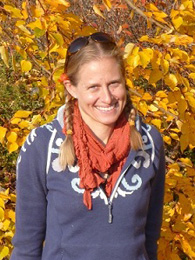|
HOME
Projects
People
Courses
Publications
Ashton's CV (pdf)
|
Ashton is a landscape ecologist who develops spatially-explicit models and data collection strategies in support of adaptive management. Many of her projects focus on developing methods to step-down wildlife habitat and population objectives from broad regional plans to local actions. She works closely with Louise to ensure that the modeling methods are suited not only to the available data, but also to the funding agency's conservation vision, scope, and objectives.
Education
- Beloit College, BA Environmental Science (1995)
- Dalhousie University, M Marine Management (1996)
- North Carolina State University, PhD Marine Science (2006)
Research & Professional Experience
- Biodiversity and Spatial Information Center, NCSU (2006-present)
- Marine Ecology and Conservation Lab, NCSU (1999-2006)
- US Environmental Protection Agency, Landscape Characterization Branch, RTP, NC (1998-1999)
- Axys Environmental Consulting, Sidney, BC (1996-1998)
- Marine Biological Laboratory, Woods Hole, MA (1994)
Teaching Experience
- Climate Change and Conservation Planning (2009)
- Hierarchical Species-Habitat Analysis and Conservation (2007 & 2008)
- Natural Resource Measurements (2003)
- Landscape Ecology (2002)
Selected Publications
Books & Book Chapters:
- Perera AH, Drew CA, Johnson CJ (eds) (2012) Expert Knowledge and its Application in Landscape Ecology. Springer, New York, NY. *external link*
- Experts, expert knowledge and their roles in landscape ecological applications (Chapter 1, Perera AH, Drew CA, Johnson CJ)
- Expert knowledge as a foundation for management of secretive species and their habitat (Chapter 5, Drew CA, Collazo JA)
- Elicitation and use of expert knowledge in landscape ecological applications: a synthesis. (Chapter 14, Drew CA, Johnson CJ, Perera AH: )
- Drew CA, Wiersma Y, Huettmann FH (eds) (2011) Predictive Species and Habitat Modeling in Landscape Ecology: Concepts and Applications. Springer, New York, NY. *external link*
- Landscape modeling of species and their habitats: history, uncertainty, and complexity (Chapter 1, Wiersma Y, Drew CA, Huettmann FH)
- The role of assumptions in predictions of habitat availability and quality (Chapter 5, Laurent E, Drew CA, Thogmartin W)
- Expert knowledge as a basis for landscape ecological predictive models (Chapter 12, Drew CA, Perera AH)
- The state of habitat and species modeling today (Chapter 15, Drew CA, Wiersma Y, Huettmann FH)
Research Articles:
- Rogers SL, Collazo JA, Drew CA (2013) Nest occurrence and survival of King Rails in fire-managed coastal marshes in North Carolina and Virginia. Journal of Field Ornithology 84(4):355–366
- Drescher M, Perera AH, Johnson CJ, Buse LJ, Drew CA, Burgman MA (2013) Toward rigorous use of expert knowledge in ecological research. Ecosphere 4(7):art83 *pdf*
- Rogers SL, Collazo JA, Drew CA (2013) Occupancy and abundance of King Rails in fire managed coastal marshes. Waterbirds 36(2):179-188
- Hightower JE, Harris JE, Raabe JK, Brownell P, Drew CA (2012) Habitat suitability models for American shad in southeastern rivers. Journal of Fish and Wildlife Management 3(2):184-198 *pdf*
- Pijanowski B, Iverson L, Rhemtulla J, Wimberly M, Drew CA, Bartsch A, Bulley H, Peng J (2010) Addressing the interplay between poverty and landscapes: a grand challenge topic for landscape ecologists. Landscape Ecology 25:5-16 *pdf*
- Drew CA, Eggleston DB (2008) Juvenile fish densities in Florida Keys mangroves correlate with landscape characteristics. Marine Ecology Progress Series 362: 233-243 *pdf*
- Drew CA, Eggleston DB (2006) Currents, landscape structure, and recruitment success along a passive-active dispersal gradient. Landscape Ecology 21: 917-931 *pdf*
- Hess GR, Rubino MJ, Koch FH, Eschelbach KA, Drew CA, Favreau JM (2006) Comparing the potential effectiveness of conservation planning approaches in central North Carolina, USA. Biological Conservation 128: 358-368 *pdf*
- Favreau JM, Drew CA, Hess GR, Eschelbach KA, Rubino MJ, Koch FH (2006) Recommendations for assessing the effectiveness of surrogate species approaches. Biodiversity and Conservation 15: 3949-3969 *pdf*
Science Education Chapters and Articles:
- Morzilla AT, Hollister JW, Drew CA, Rocca ME, Baker ME, Bossenbroek JM, Mazzarella CM (2008) A young scientist’s guide to gainful employment: recent graduates’ experiences and successful strategies. Bulletin of the Ecological Society of America 89:193-203 *pdf*
- Hess GR, Drew CA (2004) Inquiry Guided Learning through Collaborative Research. In Lee VS (ed.) Teaching and Learning through Inquiry: A Guidebook for Institutions and Instructors. Sterling, VA: Stylus Publishing.
- Drew CA, Hess GR (2003) Online publication enhances integration of current research in the classroom. Conservation Ecology 7(1): r12. [online] URL: http://www.consecol.org/vol7/iss1/resp12 *external link*
|
